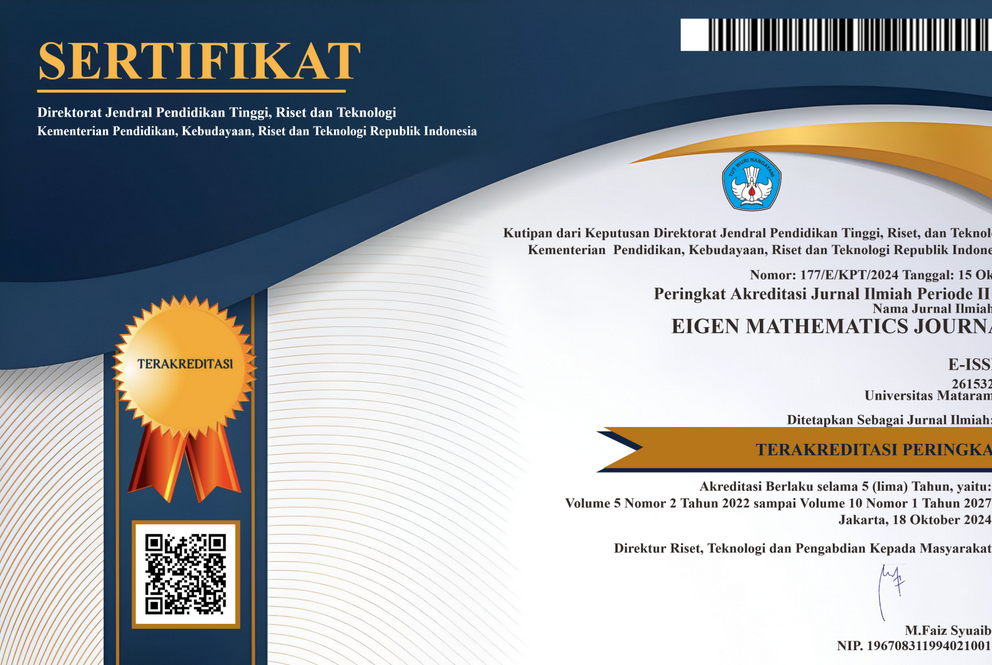Modelling the Recovery of Malaria Patients in West Lombok District Using Cox Regression
DOI:
https://doi.org/10.29303/emj.v6i2.173Keywords:
Cox Proportional Hazard Regression, Hazard Ratio, Malaria, Survival AnalysisAbstract
Malaria is one of the health problems in West Lombok Regency. There are 413 positive malaria cases, so it is necessary to research the models and factors affecting malaria sufferers' recovery. The analysis used is survival analysis using the Cox Proportional Hazard Regression method. The data used in this study is in the form of secondary data obtained from medical record data from all patients with malaria disease in West Lombok Regency from 2019 to 2020, with dependent variables in the form of recovery time of malaria patients and nine independent variables that are suspected of affecting the recovery of malaria sufferers. This study aims to determine a recovery model for malaria sufferers based on Cox regression and determine the factors that influence the recovery of malaria sufferers in West Lombok Regency. Based on the survival analysis results with the Cox Proportional hazard Regression method, the best model was obtained with two significant variables affecting the recovery time of malaria patients: the parasite type variable and the incidence of pregnancy or not getting pregnant. The model can be interpreted based on hazard ratio values that the variable type of parasite category Plasmodium vivax has a probability of being able to recover within one month of treatment by 2,542 times faster than Plasmodium falciparum. In comparison, the type of parasite in the Plasmodium mix category has a probability of being able to recover within one month of treatment 1.108 times faster than Plasmodium vivax, and for the pregnant or non-pregnant variables for the category of pregnant patients had a 2,307 times faster probability of recovery within one month of treatment compared to non-pregnant patients.References
Austin, P. C., Michael J. L., and Ewout W. S. (2017). Predictive Accuracy of Novel Risk Factors and Markers: A Simulation Study of the Sensitivity of Different Performance Measures for the Cox Proportional Hazards Regression Model. Institute for Clinical Evaluative Sciences, Toronto, Canada. Journal of SMMR, 26(3), 1053-1077.
Gayatri, D. (2005). Mengenal Analisis Ketahanan (Survival Analysis). Indonesia. Indonesian Journal of Nursing, 9(1), 36-40.
Hutahaean, Landang P., Mukid Moch. A., dan Wuryandari T. (2014). Model Regresi Cox Proportional Hazards pada Data Lama Studi Mahasiswa. Semarang: UNDIP. Jurnal Gaussian, Vol. 3, No. 2, Hal. 173-181.
Kleinbaum, D. G., and Klein M. (2012). Survival Analysis: A Self-Learning Text, Third Edition. Springer. New York.
Pahlevi, M. R., Mustafid., dan Wuryandari T. (2016). Model Regresi Cox Stratified pada Data Ketahanan. Semarang: UNDIP. Journal Gaussian, 5(3), 455-464.
Qomaria, T., Fatekurohman M., dan Anggraeni D. (2019). Aplikasi Model Cox Proportional Hazard pada Pasien Stroke RSD Balung Kabupaten Jember. Journal of Applied Statistics, 2(2), 94-112.
Rahmadeni dan Syofia Ranti. (2016). Perbandingan Model Regresi Cox Menggunakan Estimasi parameter Efron Partial Likelihood dan Breslow Partial Likelihood. Riau: UIN Sultan Syarif Kasim. Seminar Nasional Teknologi Informasi, Komunikasi dan Industri (SNTIKI). Hal. 421-430.
Rinni, Berlian A., Wuryandari T., and Rusgiyono A. (2014). Modelling the Recovery Rate of Inpatients with Typus Abdominalis (Typhoid Fever) Using the Proportional Hazard Failure Regression Model (Case Study at Semarang City Regional Hospital). Semarang: UNDIP. Journal Gaussian, 3(1), 31-40.
West Nusa Tenggara Provincial Health Office. (2019). Profil Kesehatan Provinsi Nusa Tenggara Barat 2019. West Nusa Tenggara: West Nusa Tenggara Health Office.
Downloads
Published
How to Cite
Issue
Section
License

This work is licensed under a Creative Commons Attribution-NonCommercial-ShareAlike 4.0 International License.
All articles published in the Eigen Mathematics Journal will be available for free reading and downloading. The license applied to this journal is Creative Commons Attribution-Non-Commercial-Share Alike (CC BY-NC-SA).
Most read articles by the same author(s)
- Aditya Setyawan R, Mustika Hadijati, Ni Wayan Switrayni, Analisis Masalah Heteroskedastisitas Menggunakan Generalized Least Square dalam Analisis Regresi , EIGEN MATHEMATICS JOURNAL: Vol. 2 No. 2 Desember 2019
- Ni Luh Putu Dewi Wikayanti, Qurratul Aini, Nurul Fitriyani, Pengaruh Kurs Dolar Amerika Serikat, Inflasi, dan Tingkat Suku Bunga Terhadap Indeks Harga Saham Gabungan Dengan Vector Error Correction , EIGEN MATHEMATICS JOURNAL: Vol. 3 No. 1 Juni 2020
- Himayati Himayati, Ni Wayan Switrayni, Desy Komalasari, Nurul Fitriyani, Analisis Rotasi Ortogonal pada Teknik Analisis Faktor Menggunakan Metode Procrustes , EIGEN MATHEMATICS JOURNAL: Vol. 3 No. 1 Juni 2020
- Nirwana Nirwana, Mustika Hadijati, Nurul Fitriyani, Estimasi Parameter Model Moving Average Orde 1 Menggunakan Metode Momen dan Maximum Likelihood , EIGEN MATHEMATICS JOURNAL: Vol. 1 No. 1: Juni 2018
- Moudy Puspita Ayudhiah, Syamsul Bahri, Nurul Fitriyani, Peramalan Indeks Harga Konsumen Kota Mataram Menggunakan Vector Autoregressive Integrated Moving Average , EIGEN MATHEMATICS JOURNAL: Vol. 3 No. 1 Juni 2020
- Jusmawati Jusmawati, Mustika Hadijati, Nurul Fitriyani, Penerapan Model Vector Autoregressive Integrate Moving Average dalam Peramalan Laju Inflasi dan Suku Bunga di Indonesia , EIGEN MATHEMATICS JOURNAL: VOL. 3 NO. 2 DESEMBER 2020
- Deni Pratiwi, Lalu Abd Azis Mursy, Muhammad Rizaldi, Nurul Fitriyani, Regresi Nonparametrik Kernel Gaussian pada Pemodelan Angka Kelahiran Kasar di Provinsi Nusa Tenggara Barat , EIGEN MATHEMATICS JOURNAL: VOL. 3 NO. 2 DESEMBER 2020
- Ulfa Destiarina, Mustika Hadijati, Desy Komalasari, Nurul Fitriyani, Estimasi Parameter Distribusi Mixture Eksponensial dan Weibull dengan Metode Bayesian Markov Chain Monte Carlo , EIGEN MATHEMATICS JOURNAL: Vol. 2 No. 1 Juni 2019
- Bidayani Bidayani, Mustika Hadijati, Nurul Fitriyani, Model Regresi Semiparametrik Spline Hasil Produksi Padi di Kabupaten Lombok Timur , EIGEN MATHEMATICS JOURNAL: Vol. 2 No. 1 Juni 2019
- Nurul - Insan, Mustika Hadijati, Irwansyah Irwansyah, Perbandingan Metode Classification and Regression Trees (CART) dengan Naïve Bayes Classification (NBC) dalam Klasifikasi Status Gizi Balita di Kelurahan Pagesangan Barat , EIGEN MATHEMATICS JOURNAL: Vol. 3 No. 1 Juni 2020






